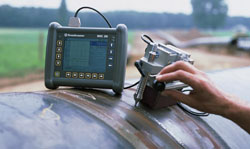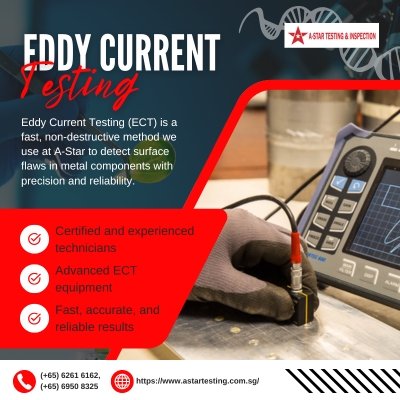Eddy Current Testing (ECT) is a sophisticated non-destructive testing (NDT) method leveraging electromagnetism principles for detecting flaws in conductive materials. At A-STAR Testing & Inspection (S) PTE LTD, located at No.5 Soon Lee Street, #03-36/37 Pioneer Point, Singapore, we specialize in providing top-tier ECT services to ensure the integrity and safety of your materials and structures.
Understanding Eddy Current Testing
ECT employs a specially designed coil energized with an alternating current. When this coil is placed near the test surface, it generates a magnetic field that interacts with the material, producing eddy currents. Variations in these eddy currents, caused by changes in electrical conductivity, magnetic permeability, or the presence of discontinuities, are monitored to detect flaws. These changes are displayed on a screen, allowing our skilled technicians to interpret and identify potential defects.
The ECT Process
The foundation of ECT lies in electromagnetic induction. When an alternating current passes through a conductor, it creates an alternating magnetic field. Bringing this field close to another conductor induces eddy currents, which in turn generate their own magnetic fields. Variations in these fields, due to flaws or material properties, are detected using the primary or secondary coils, forming the basis of ECT inspection.


Non-Contact Method: This allows for the inspection of high-temperature and underwater surfaces without physical contact. Quick and Efficient: Minimal preparation time is required, and surfaces need little pre-cleaning. The method provides immediate feedback, making it highly efficient.
Versatile: ECT can inspect complex geometries and various materials, including ferrous and non-ferrous metals.
Portable Equipment: The testing equipment is lightweight and portable, allowing for easy on-site inspections.
Limitations
Despite its advantages, ECT has limitations. It can only be used on conductive materials, and its depth of penetration is variable. ECT is also sensitive to changes in magnetic permeability, which can complicate testing of welds in ferromagnetic materials. Additionally, defects parallel to the surface are difficult to detect, requiring careful signal interpretation to differentiate between relevant and non-relevant indications.
Applications of ECT
ECT is versatile, with applications including:
Welded Joints: Detecting cracks, lack of fusion, and other defects in welds.
Tube Inspections: Examining the bores of in-service tubes and bolt holes.
Aircraft Industry: Checking for corrosion and defects in aircraft skins.
General Industry: Inspecting gas turbine blades, cast iron bridges, and nozzle welds in nuclear reactors.
At A-STAR Testing & Inspection, we ensure the highest standards of quality and safety. Our technicians are highly skilled and trained, undergoing regular assessments to maintain their expertise.
For more information or to schedule an inspection, contact us at:
Phone: (+65) 6261 6162, (+65) 6950 8325
Email: enquiry@astartesting.com.sg
Website: www.astartesting.com.sg
Discover how our advanced ECT services can help ensure the safety and integrity of your critical structures and components.
Must Be Visit At: https://www.astartesting.co.in

